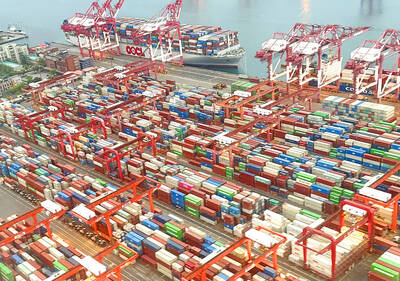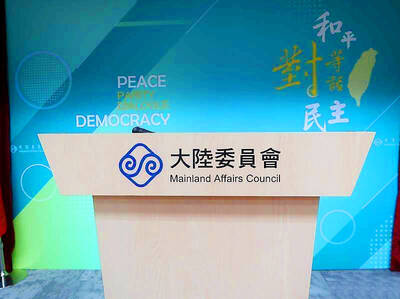Despite efforts by the administration of President Ma Ying-jeou (馬英九) to lower tensions in the Taiwan Strait, the Chinese military continues to build up its missile threat against its neighbor, according to recent reports of modernization efforts at missile bases in China’s Fujian Province.
Reports late last month said recent US spy satellite imagery had uncovered what appeared to be evidence of new missile launch pads in Fujian Province, including in Xianyou in the province’s southeast, directly -opposite Taiwan.
However, according to the latest issue of British defense magazine Jane’s Defence Weekly, the imagery was likely evidence of modernization of an old People’s Liberation Army (PLA) missile brigade under direct control of the Nanjing Military Region rather than new missile bases.
Military analysts suspect that command of the ground support missile brigade at Xianyou, which became operational in 1993, was recently shifted to the Second Artillery Corps, which oversees China’s conventional and nuclear ballistic missile forces.
Prior to falling under control of the Second Artillery’s 52 Base, the missile brigade around Xianyou comprised about 100 Dong Feng 11 (DF-11) short-range (300km) ballistic missiles (SRBM).
As part of ongoing modernization efforts, those missiles are now believed to be in the process of being replaced by the more modern 600km-range DF-11As, Jane’s said.
The DF-11 is a solid-fuel, road-mobile SRBM carried on transporter erector launcher (TEL) vehicles.
In earlier reports, Kanwa Asia Defense Review claimed that along with new equipment, the base may also have been given a new mission, Jane’s reported.
The Second Artillery’s main ballistic missile base in Fujian, 817 Brigade, is located in Yongan City. Six brigades of DF-11As are believed to be based there.
The brigades at Xianyou and Yongan are part of the PLA’s ballistic missile force, estimated at 1,500 missiles, targeted at Taiwan, an arsenal that includes medium-range DF-15s and DF-16s, as well as hundreds of cruise missiles.
Commenting on the imagery, Kanwa Asia Defense Review claimed that two of the new launch pads were constructed in northern Fujian, with one located 100km northwest of Fuzhou, less than 260km from Taipei.
At least two launch pads have also been detected on mountaintops in the Huashuang area, about 270km from Taipei. Yet another launch pad has been spotted 209km from Taipei, which the magazine said was also built prior to 2007 and is now under the control of No. 820 artillery brigade based in Jinhua, Zhejiang Province.
However, Gary Li, an intelligence analyst at UK-based Exclusive Analysis, said that without closer analysis of the imagery, it was impossible to rule out the possibility that some of the so-called launch pads seen around Fujian were fake TELs — which the PLA has reportedly been fielding in increasing numbers to deceive satellites — or long-range multiple rocket launchers such as the PHL-03s used by the army.
Commenting on the reports, local military experts said China had also strengthened its ability to protect its ballistic missiles with air-defense systems.
Ministry of National Defense spokesman David Lo (羅紹和) said the ministry has stepped up its monitoring of China’s military deployments and movements and would work out response strategies to protect national security.
The reports come amid news that three Patriot Advanced Capability-2 (PAC-2) surface-to-air missile defense units acquired by Taiwan in the late 1990s were recently returned to Taiwan after being upgraded to PAC-3 configuration in the US.
Additional reporting by CNA

MORE VISITORS: The Tourism Administration said that it is seeing positive prospects in its efforts to expand the tourism market in North America and Europe Taiwan has been ranked as the cheapest place in the world to travel to this year, based on a list recommended by NerdWallet. The San Francisco-based personal finance company said that Taiwan topped the list of 16 nations it chose for budget travelers because US tourists do not need visas and travelers can easily have a good meal for less than US$10. A bus ride in Taipei costs just under US$0.50, while subway rides start at US$0.60, the firm said, adding that public transportation in Taiwan is easy to navigate. The firm also called Taiwan a “food lover’s paradise,” citing inexpensive breakfast stalls

TRADE: A mandatory declaration of origin for manufactured goods bound for the US is to take effect on May 7 to block China from exploiting Taiwan’s trade channels All products manufactured in Taiwan and exported to the US must include a signed declaration of origin starting on May 7, the Bureau of Foreign Trade announced yesterday. US President Donald Trump on April 2 imposed a 32 percent tariff on imports from Taiwan, but one week later announced a 90-day pause on its implementation. However, a universal 10 percent tariff was immediately applied to most imports from around the world. On April 12, the Trump administration further exempted computers, smartphones and semiconductors from the new tariffs. In response, President William Lai’s (賴清德) administration has introduced a series of countermeasures to support affected

CROSS-STRAIT: The vast majority of Taiwanese support maintaining the ‘status quo,’ while concern is rising about Beijing’s influence operations More than eight out of 10 Taiwanese reject Beijing’s “one country, two systems” framework for cross-strait relations, according to a survey released by the Mainland Affairs Council (MAC) on Thursday. The MAC’s latest quarterly survey found that 84.4 percent of respondents opposed Beijing’s “one country, two systems” formula for handling cross-strait relations — a figure consistent with past polling. Over the past three years, opposition to the framework has remained high, ranging from a low of 83.6 percent in April 2023 to a peak of 89.6 percent in April last year. In the most recent poll, 82.5 percent also rejected China’s

PLUGGING HOLES: The amendments would bring the legislation in line with systems found in other countries such as Japan and the US, Legislator Chen Kuan-ting said Democratic Progressive Party (DPP) Legislator Chen Kuan-ting (陳冠廷) has proposed amending national security legislation amid a spate of espionage cases. Potential gaps in security vetting procedures for personnel with access to sensitive information prompted him to propose the amendments, which would introduce changes to Article 14 of the Classified National Security Information Protection Act (國家機密保護法), Chen said yesterday. The proposal, which aims to enhance interagency vetting procedures and reduce the risk of classified information leaks, would establish a comprehensive security clearance system in Taiwan, he said. The amendment would require character and loyalty checks for civil servants and intelligence personnel prior to